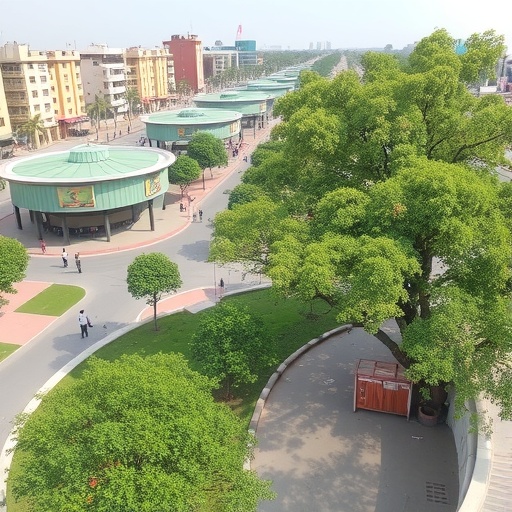Urban green spaces play a pivotal role in enhancing the quality of life in cities worldwide. With burgeoning populations and rapid urbanization, the challenge of maintaining ecological balance while catering to human needs intensifies. Recent research by P.K. Rajput highlights how graph theory can be employed to optimize urban green space connectivity, particularly in Bhopal city, India. This study not only sheds light on the ecological planning of green spaces but also emphasizes their critical role in urban development.
The concept of urban green spaces encompasses parks, gardens, and other green areas that provide habitats for wildlife, recreational opportunities for residents, and avenues for environmental sustainability. The study accentuates that increased connectivity among these spaces is essential for fostering biodiversity, reducing urban heat islands, and enhancing air quality. However, the fragmentation often seen in urban environments poses a significant barrier to achieving these benefits. Rajput’s research utilizing graph theory aims to address this challenge.
Graph theory, a branch of mathematics that studies graphs as a representation of pairwise relationships between objects, has found various applications across disciplines. In the context of urban planning, it serves as a powerful tool to analyze and optimize the interconnectedness of green spaces. By evaluating the network of parks and green corridors through this mathematical lens, Rajput is able to assess their accessibility and the degree of connectivity amongst them. This analysis reveals critical insights into how urban inhabitants interact with these green spaces.
One of the critical outcomes of Rajput’s study is the identification of key nodes and connections within the green space network of Bhopal. By establishing a graph-based model, the research visually portrays the strengths and weaknesses in the current layout of urban green spaces. This model not only pinpoints areas with high connectivity but also highlights regions that are isolated or under-served in terms of green space access, providing a directional framework for future urban planning initiatives.
Ecological consequences of fragmented urban landscapes have been extensively documented. For instance, isolated green spaces can lead to a decrease in species diversity as animals and plants become trapped in segregated environments. Rajput illustrates how enhancing connectivity can mitigate this issue by enabling species movement and fostering greater ecological resilience. The research advocates for strategies to integrate green corridors that connect these spaces, thus promoting biodiversity and allowing for a healthier ecosystem within urban confines.
Moreover, the psychological and social implications of urban green spaces cannot be overstated. Access to nature has been shown to improve mental health, reduce stress levels, and foster community bonds. Rajput stresses the importance of considering these human factors when planning urban green spaces. By employing graph theory, planners can ensure that these areas are not only ecologically viable but also accessible and attractive to residents, ultimately leading to healthier, happier communities.
The findings from this research can guide policymakers in making informed decisions regarding urban green space development. By using the graph-based assessments, municipalities can prioritize projects that will enhance connectivity in areas with limited access to green spaces. This ensures that urban development is strategically aligned with ecological principles, fostering sustainability while meeting the needs of urban populations.
In addition to local implications, the research also contributes to broader discussions about urbanization and its impact on ecology. As cities globally face similar challenges related to urban sprawl and habitat fragmentation, Rajput’s findings present a model that can be replicated in different contexts. This comparative analysis can offer critical insights into how cities can utilize graph theory to create greener, more interconnected urban landscapes, enhancing ecological sustainability.
Still, the journey does not end with the identification of connectivity gaps and potential solutions. Continuous monitoring and adaptive management are essential to ensure that urban green spaces evolve in conjunction with changing urban dynamics and populations. Rajput emphasizes the necessity for an ongoing assessment framework that uses graph theory to adapt to these changes effectively.
As urban planners and researchers look to future developments, the intersection of technology, ecology, and human needs will remain a focal point. This research exemplifies how expanding the toolkit of urban planners with innovative methodologies like graph theory can lead to smarter, more sustainable city design. Ultimately, it poses the foundational question: how can cities retain their green identities amid an ever-expanding urban footprint?
Rajput’s work exemplifies a significant step forward in understanding and enhancing urban green space connectivity. It not only provides actionable insights into Bhopal’s ecological planning but also serves as a beacon for cities around the world grappling with similar challenges. As awareness grows and methodologies evolve, the integration of ecology into the fabric of urban life becomes ever more essential for safeguarding our planet’s future.
In summary, Rajput’s research is a clarion call to urban planners, policymakers, and residents alike, urging them to recognize the invaluable role that interconnected urban green spaces play in fostering both ecological health and human well-being. It highlights the necessity of innovative approaches to urban planning that embrace mathematical frameworks like graph theory, paving the way for cities to thrive sustainably in the face of future challenges.
Subject of Research: Urban green space connectivity in Bhopal city, India
Article Title: Graph theory-based assessment of urban green space connectivity for ecological planning in Bhopal city, India
Article References:
Rajput, P.K. Graph theory-based assessment of urban green space connectivity for ecological planning in Bhopal city, India.
Discov Cities 2, 110 (2025). https://doi.org/10.1007/s44327-025-00152-5
Image Credits: AI Generated
DOI: https://doi.org/10.1007/s44327-025-00152-5
Keywords: urban green space, connectivity, graph theory, ecological planning, Bhopal city, urbanization, biodiversity, ecological sustainability, mental health, community well-being.




